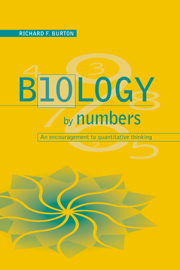Book contents
- Frontmatter
- Contents
- Preface
- A guide to the book
- 1 Putting two and two together
- 2 Units, formulae and the use of old envelopes: confronting some obstacles to quantitative thinking
- 3 Aspects of energy metabolism
- 4 Getting things in proportion
- 5 Perilous percentages, dangerous ratios
- 6 Building a trophic pyramid
- 7 Sodium in animals and plants
- 8 Exchanges of water and carbon dioxide
- 9 A geometric series
- 10 Introduction to logarithms
- 11 Bringing logarithms to life
- 12 Exponential relationships
- 13 Aspects of allometry
- 14 More on allometry, and on quantitative patterns in nature
- 15 How the abundance of food affects rates of feeding
- 16 The characterization of trees and other branching systems
- 17 Epilogue
- References
- Notes
- Index
6 - Building a trophic pyramid
Published online by Cambridge University Press: 05 June 2012
- Frontmatter
- Contents
- Preface
- A guide to the book
- 1 Putting two and two together
- 2 Units, formulae and the use of old envelopes: confronting some obstacles to quantitative thinking
- 3 Aspects of energy metabolism
- 4 Getting things in proportion
- 5 Perilous percentages, dangerous ratios
- 6 Building a trophic pyramid
- 7 Sodium in animals and plants
- 8 Exchanges of water and carbon dioxide
- 9 A geometric series
- 10 Introduction to logarithms
- 11 Bringing logarithms to life
- 12 Exponential relationships
- 13 Aspects of allometry
- 14 More on allometry, and on quantitative patterns in nature
- 15 How the abundance of food affects rates of feeding
- 16 The characterization of trees and other branching systems
- 17 Epilogue
- References
- Notes
- Index
Summary
It is a well-known generalization in ecology that the various trophic levels in an ecosystem tend to form a ‘pyramid’ with regard to productivity and usually biomass. Forming the base of the pyramid and having the greatest productivity are the plants, the primary producers that fix carbon dioxide and solar energy and pass it on to other organisms. Successively upwards on this support are those animals that eat the plants and then the carnivorous ones that eat them and which are present in yet smaller quantity. To this one may add, at the top in smallest total mass, the predators of predators, plus such complications as omnivores, parasites and the very important decomposers, but in the interest of simplicity (a rare word in the science of ecology, I suspect) only the first three trophic levels are considered here and all the animals are mammals. The tapering of the pyramid may be understood in terms of materials such as carbon and protein nitrogen that are passed on incompletely from one level to another. Thus, a population of rabbits obtains carbon from vegetation and breathes much of it out as carbon dioxide before perhaps passing on a portion of the remainder to a much smaller population of foxes. However, the pyramid is more usually analysed in terms of energy, and that is what we do first, starting with the relationship between predators and prey.
- Type
- Chapter
- Information
- Biology by NumbersAn Encouragement to Quantitative Thinking, pp. 69 - 80Publisher: Cambridge University PressPrint publication year: 1998



